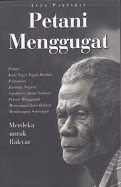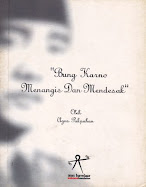The Jakarta Post , Jakarta | Sat, 05/07/2005 4:28 PM | Opinion
Agus Pakpahan, Jakarta
If we assume that the average annual growth of the Indonesian economy is 5 percent, Indonesia will reach the level of Malaysia's 2002 per capita income in 2035. Using Malaysia's 2002 economic structure as our benchmark shows that in 2035 our economy will still be dependent on agriculture. It means that we have not only to focus our attention on how to revitalize agriculture but also have to care for agriculture.
When we say that our future will still be dependent on agriculture, what precisely do we mean by agriculture? Agriculture is an industry that is based on culture. Culture is simply the way a community thinks and feels and what it believes. In terms of cultivation, agricultural communities, i.e., farmers, based on their wealth of knowledge and technology, utilize solar energy, soil, water and plants or animals to serve people's needs for food, fiber, energy and other products.
Sugarcane is one of the oldest cultivated plants on Java. One story tells us that sugarcane has been used since King Aji Saka in 75 A.D. There are some myths or legends about sugarcane in Indonesia that reflect the importance of sugarcane in our culture. Marco Polo who visited Java in 1285 noticed that sugarcane was a modern industry at that time. In 1930, sugarcane production on Java reached almost 3 million tons and Java was the world's second largest sugar exporter in that period.
Sugar was one of the most valuable commodities in the 19th century and early 20th century. That is why due to its contribution to the Dutch economy, sugarcane, together with coffee, was a top commodity in the cultivation system (cultuurstelsel). However, there is a growing opinion that the sugar industry is in its sunset years. Therefore, its prospects are not bright.
To what extent that view is right depends on the context. The newest era in global civilization is reflected in an economy based on knowledge and information economy.
However, even though we know that the new economy would give us bright prospects, most of our labor force is not equipped for the new economy. Most of our people are still in the agrarian age.
In fact, agriculture will still dominate in 2035. Therefore, we have no other recourse but to make a living by revitalizing agriculture. Our agriculture is in a very difficult position now. One of the most frightening indicators is the decline in the annual total factor productivity (TFP) from 2.6 percent (1968-92) to -0.1 percent (1993-2000) (Fuglie, 2004).
There are many factors that have contributed to declining productivity growth. One of the most important factors is farmers' income. Declining agricultural prices over a long period has been a significant contributing factor to farmers' declining income. According the World Bank the world's agriculture price index (aggregate) had declined from 208 in 1960 to 87 in 2000.
As an illustration, the price of palm oil and sugar on the international market was US$1507/metric ton and $0.33/kilogram in 1960, respectively. The price of palm oil and sugar declined to $307/ton and $0.18/kg, respectively in 2000.
Among agricultural commodities in Indonesia, sugar is one of products that experienced both increasing production and farmers' income. Indonesia's sugar production was only 1.49 million ton in 1998. Sugar production in 2005 is predicted to reach 2.2 million ton. A major cause of increasing sugarcane production is improvement in sugar prices received by farmers.
Why has the price of sugar been improving since 2002? The major reason is the increasing capability of farmers' organizations to organize themselves to market their sugar. Before 1998, farmers' sugar was marketed by external agencies, namely State Owned Enterprises SOEs). Since 1998, farmers have marketed their sugar themselves. Sixty-five percent of sugar produced on Java is owned by farmers, and the rest is owned by SOEs.
The Sugarcane Farmers Association initiated a marketing arrangement between farmers and a large sugar trader in 2001. One of the most important arrangements was the trader provided a minimum price to sugarcane farmers agreed upon by both parties. In addition, farmers also received a proportion of price difference between the minimum price and an auction price.
In order to stabilize the sugar market from sugar smuggling, the association asked the government to enact Ministry of Industry and Trade Decree No. 643, 2002. Since then farmers' sugar trading has followed that scheme.
There have been some disputes about the above scheme since the beginning. However, if we use farmers' income and production growth as the main yardstick we cannot deny that the marketing arrangement initiated by sugarcane farmers and their partners (traders who later became investors) is important knowledge for innovative marketing of other agricultural commodities.
We have followed studies and seminars, and we have also developed institutions and commissions to find ways to solve poverty, employment opportunities, and sources of income. We have spent so much energy and money, but we have not seen any results. We should appreciate what has been contributed by sugarcane farmers. Such an innovative approach is also applicable to rice, corn, palm oil, rubber, etc., if we want to be able to revitalize our agricultural sector.
The sugar industry is one of the most developed agrarian-based industries we have.
The writer is the chairman of the Union of the Association of Indonesian Crops Farmers (Gapperindo).











Tidak ada komentar:
Posting Komentar